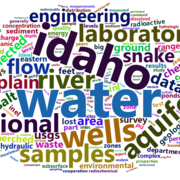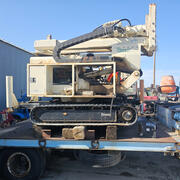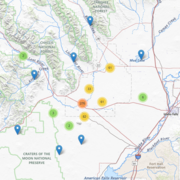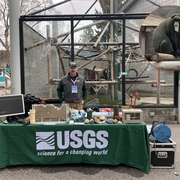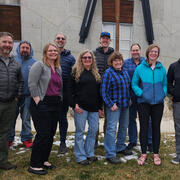Brian V Twining
Brian Twining is the Chief of the USGS Idaho Water Science Center's Idaho National Laboratory Project Office in Idaho Falls, Idaho.
Brian has served with the USGS Idaho National Laboratory Project Office since 1998. Prior to becoming the project office chief, he led the geotechnical drilling and geophysical logging programs. His scientific research involves groundwater monitoring systems, aquifer testing, geophysical logging and data analysis, and project management and coordination.
Professional Experience
Project Chief, USGS Idaho National Laboratory Project Office, August 2021 - Present
Supervisory Hydrologist, USGS Idaho National Laboratory Project Office, August 2010 – August 2021
Hydrologist, USGS Idaho National Laboratory Project Office, May 2002 – August 2010
Hydrologic Technician, USGS Idaho National Laboratory Project Office June 1998 – May 2002
Education and Certifications
M.S. Hydrology, 2001, University of Idaho
B.S. Geology and Environmental Science, 1996, University of Idaho
Affiliations and Memberships*
National Groundwater Association (NGWA)
Science and Products
Completion summary for monitor wells NRF-17 and NRF-18 at the Naval Reactors Facility, Idaho National Laboratory, Idaho Completion summary for monitor wells NRF-17 and NRF-18 at the Naval Reactors Facility, Idaho National Laboratory, Idaho
Completion summary for Borehole TAN-2336 at Test Area North, Idaho National Laboratory, Idaho Completion summary for Borehole TAN-2336 at Test Area North, Idaho National Laboratory, Idaho
Completion summary for boreholes USGS 148, 148A, and 149 at the Materials and Fuels Complex, Idaho National Laboratory, Idaho Completion summary for boreholes USGS 148, 148A, and 149 at the Materials and Fuels Complex, Idaho National Laboratory, Idaho
Multilevel groundwater monitoring of hydraulic head, water temperature, and chemical constituents in the eastern Snake River Plain aquifer, Idaho National Laboratory, Idaho, 2014–18 Multilevel groundwater monitoring of hydraulic head, water temperature, and chemical constituents in the eastern Snake River Plain aquifer, Idaho National Laboratory, Idaho, 2014–18
Transmissivity and geophysical data for selected wells at and near the Idaho National Laboratory, Idaho, 2017–18 Transmissivity and geophysical data for selected wells at and near the Idaho National Laboratory, Idaho, 2017–18
Completion summary for borehole TAN-2312 at Test Area North, Idaho National Laboratory, Idaho Completion summary for borehole TAN-2312 at Test Area North, Idaho National Laboratory, Idaho
Drilling, construction, geophysical log data, and lithologic log for boreholes USGS 142 and USGS 142A, Idaho National Laboratory, Idaho Drilling, construction, geophysical log data, and lithologic log for boreholes USGS 142 and USGS 142A, Idaho National Laboratory, Idaho
Borehole deviation and correction factor data for selected wells in the eastern Snake River Plain aquifer at and near the Idaho National Laboratory, Idaho Borehole deviation and correction factor data for selected wells in the eastern Snake River Plain aquifer at and near the Idaho National Laboratory, Idaho
Characterization of sediment and measurement of groundwater levels and temperatures, Camas National Wildlife Refuge, eastern Idaho Characterization of sediment and measurement of groundwater levels and temperatures, Camas National Wildlife Refuge, eastern Idaho
Completion summary for boreholes TAN-2271 and TAN‑2272 at Test Area North, Idaho National Laboratory, Idaho Completion summary for boreholes TAN-2271 and TAN‑2272 at Test Area North, Idaho National Laboratory, Idaho
Hydrologic influences on water-level changes in the Eastern Snake River Plain aquifer at and near the Idaho National Laboratory, Idaho, 1949-2014 Hydrologic influences on water-level changes in the Eastern Snake River Plain aquifer at and near the Idaho National Laboratory, Idaho, 1949-2014
Multilevel groundwater monitoring of hydraulic head and temperature in the eastern Snake River Plain aquifer, Idaho National Laboratory, Idaho, 2011-13 Multilevel groundwater monitoring of hydraulic head and temperature in the eastern Snake River Plain aquifer, Idaho National Laboratory, Idaho, 2011-13
INLPO Publications
INLPO Drilling and Coring
INLPO Geophysical and Video Logging
INLPO Monitoring Networks
INLPO Outreach
Idaho National Laboratory Project Office (INLPO)
Drilling, construction, geophysical data, and lithologic log for borehole USGS 150 Drilling, construction, geophysical data, and lithologic log for borehole USGS 150
Geophysical and video logs of eight wells in the Camas prairie, Idaho Geophysical and video logs of eight wells in the Camas prairie, Idaho
Geophysical and video logs of four wells from the Mountain Home area, Idaho Geophysical and video logs of four wells from the Mountain Home area, Idaho
Multilevel Monitoring System (MLMS) datasets for wells in the U.S. Geological Survey - Idaho National Laboratory groundwater monitoring network Multilevel Monitoring System (MLMS) datasets for wells in the U.S. Geological Survey - Idaho National Laboratory groundwater monitoring network
Drilling, construction, geophysical data, and lithologic log for borehole USGS 145 Drilling, construction, geophysical data, and lithologic log for borehole USGS 145
Drilling, construction, geophysical data, and lithologic log for borehole USGS 144 Drilling, construction, geophysical data, and lithologic log for borehole USGS 144
Drilling, construction, geophysical, water quality, and aquifer test data for well SEP 16, Butte County, Idaho Drilling, construction, geophysical, water quality, and aquifer test data for well SEP 16, Butte County, Idaho
Drilling, construction, geophysical data, and lithologic logs for borehole USGS 152 Drilling, construction, geophysical data, and lithologic logs for borehole USGS 152
Geophysical and lithologic data for 12 boreholes in Raft River Valley, Idaho Geophysical and lithologic data for 12 boreholes in Raft River Valley, Idaho
Drilling, construction, geophysical data, and lithologic log for borehole USGS 151 Drilling, construction, geophysical data, and lithologic log for borehole USGS 151
mlms---Multilevel Monitoring System (MLMS) data storage and processing for the U.S. Geological Survey Idaho National Laboratory Project Office mlms---Multilevel Monitoring System (MLMS) data storage and processing for the U.S. Geological Survey Idaho National Laboratory Project Office
Science and Products
Completion summary for monitor wells NRF-17 and NRF-18 at the Naval Reactors Facility, Idaho National Laboratory, Idaho Completion summary for monitor wells NRF-17 and NRF-18 at the Naval Reactors Facility, Idaho National Laboratory, Idaho
Completion summary for Borehole TAN-2336 at Test Area North, Idaho National Laboratory, Idaho Completion summary for Borehole TAN-2336 at Test Area North, Idaho National Laboratory, Idaho
Completion summary for boreholes USGS 148, 148A, and 149 at the Materials and Fuels Complex, Idaho National Laboratory, Idaho Completion summary for boreholes USGS 148, 148A, and 149 at the Materials and Fuels Complex, Idaho National Laboratory, Idaho
Multilevel groundwater monitoring of hydraulic head, water temperature, and chemical constituents in the eastern Snake River Plain aquifer, Idaho National Laboratory, Idaho, 2014–18 Multilevel groundwater monitoring of hydraulic head, water temperature, and chemical constituents in the eastern Snake River Plain aquifer, Idaho National Laboratory, Idaho, 2014–18
Transmissivity and geophysical data for selected wells at and near the Idaho National Laboratory, Idaho, 2017–18 Transmissivity and geophysical data for selected wells at and near the Idaho National Laboratory, Idaho, 2017–18
Completion summary for borehole TAN-2312 at Test Area North, Idaho National Laboratory, Idaho Completion summary for borehole TAN-2312 at Test Area North, Idaho National Laboratory, Idaho
Drilling, construction, geophysical log data, and lithologic log for boreholes USGS 142 and USGS 142A, Idaho National Laboratory, Idaho Drilling, construction, geophysical log data, and lithologic log for boreholes USGS 142 and USGS 142A, Idaho National Laboratory, Idaho
Borehole deviation and correction factor data for selected wells in the eastern Snake River Plain aquifer at and near the Idaho National Laboratory, Idaho Borehole deviation and correction factor data for selected wells in the eastern Snake River Plain aquifer at and near the Idaho National Laboratory, Idaho
Characterization of sediment and measurement of groundwater levels and temperatures, Camas National Wildlife Refuge, eastern Idaho Characterization of sediment and measurement of groundwater levels and temperatures, Camas National Wildlife Refuge, eastern Idaho
Completion summary for boreholes TAN-2271 and TAN‑2272 at Test Area North, Idaho National Laboratory, Idaho Completion summary for boreholes TAN-2271 and TAN‑2272 at Test Area North, Idaho National Laboratory, Idaho
Hydrologic influences on water-level changes in the Eastern Snake River Plain aquifer at and near the Idaho National Laboratory, Idaho, 1949-2014 Hydrologic influences on water-level changes in the Eastern Snake River Plain aquifer at and near the Idaho National Laboratory, Idaho, 1949-2014
Multilevel groundwater monitoring of hydraulic head and temperature in the eastern Snake River Plain aquifer, Idaho National Laboratory, Idaho, 2011-13 Multilevel groundwater monitoring of hydraulic head and temperature in the eastern Snake River Plain aquifer, Idaho National Laboratory, Idaho, 2011-13
INLPO Publications
INLPO Drilling and Coring
INLPO Geophysical and Video Logging
INLPO Monitoring Networks
INLPO Outreach
Idaho National Laboratory Project Office (INLPO)
Drilling, construction, geophysical data, and lithologic log for borehole USGS 150 Drilling, construction, geophysical data, and lithologic log for borehole USGS 150
Geophysical and video logs of eight wells in the Camas prairie, Idaho Geophysical and video logs of eight wells in the Camas prairie, Idaho
Geophysical and video logs of four wells from the Mountain Home area, Idaho Geophysical and video logs of four wells from the Mountain Home area, Idaho
Multilevel Monitoring System (MLMS) datasets for wells in the U.S. Geological Survey - Idaho National Laboratory groundwater monitoring network Multilevel Monitoring System (MLMS) datasets for wells in the U.S. Geological Survey - Idaho National Laboratory groundwater monitoring network
Drilling, construction, geophysical data, and lithologic log for borehole USGS 145 Drilling, construction, geophysical data, and lithologic log for borehole USGS 145
Drilling, construction, geophysical data, and lithologic log for borehole USGS 144 Drilling, construction, geophysical data, and lithologic log for borehole USGS 144
Drilling, construction, geophysical, water quality, and aquifer test data for well SEP 16, Butte County, Idaho Drilling, construction, geophysical, water quality, and aquifer test data for well SEP 16, Butte County, Idaho
Drilling, construction, geophysical data, and lithologic logs for borehole USGS 152 Drilling, construction, geophysical data, and lithologic logs for borehole USGS 152
Geophysical and lithologic data for 12 boreholes in Raft River Valley, Idaho Geophysical and lithologic data for 12 boreholes in Raft River Valley, Idaho
Drilling, construction, geophysical data, and lithologic log for borehole USGS 151 Drilling, construction, geophysical data, and lithologic log for borehole USGS 151
mlms---Multilevel Monitoring System (MLMS) data storage and processing for the U.S. Geological Survey Idaho National Laboratory Project Office mlms---Multilevel Monitoring System (MLMS) data storage and processing for the U.S. Geological Survey Idaho National Laboratory Project Office
*Disclaimer: Listing outside positions with professional scientific organizations on this Staff Profile are for informational purposes only and do not constitute an endorsement of those professional scientific organizations or their activities by the USGS, Department of the Interior, or U.S. Government


